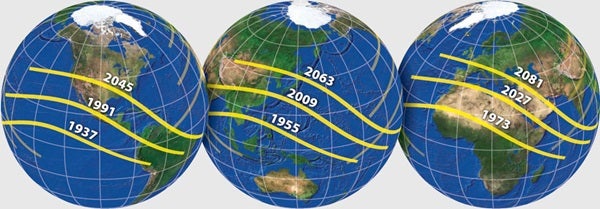The Saros cycle arises from a natural synchronization among three of the Moon’s periods: synodical (the time from New Moon to New Moon), anomalistic (the time from the closest Earth-Moon distance to the next), and draconic (the interval between the Moon’s orbit crossing Earth’s — this point is called a node). Two eclipses of the same saros occur at the same node when the Moon is at nearly the same distance from Earth and at the same time of year. A saros is equal to 223 synodical months, which is also the same as 239 anomalistic months and 242 draconic months to within a few hours.
The July 1, 2011, partial solar eclipse was brief and visible only from the ocean off Antarctica. Over the next 1,000 years, every 18 years and 11 1/3 days, this eclipse will move northward on Earth and will grow longer and become central (total or annular), before it declines, turns partial again, and moves off the North Pole. — Jay M. Pasachoff, Hopkins Observatory of Williams College, Williamstown, Massachusetts










